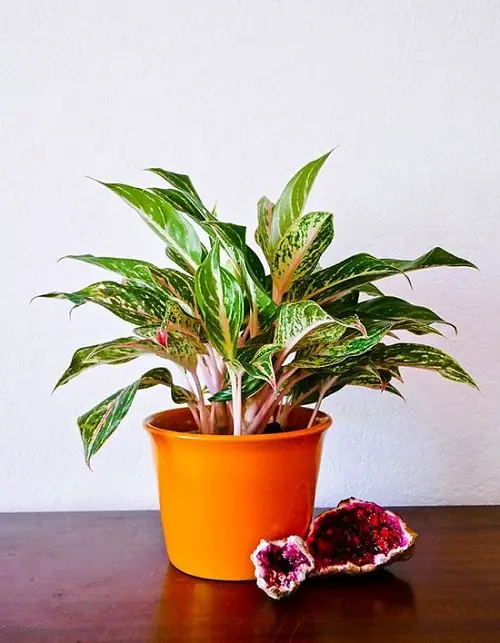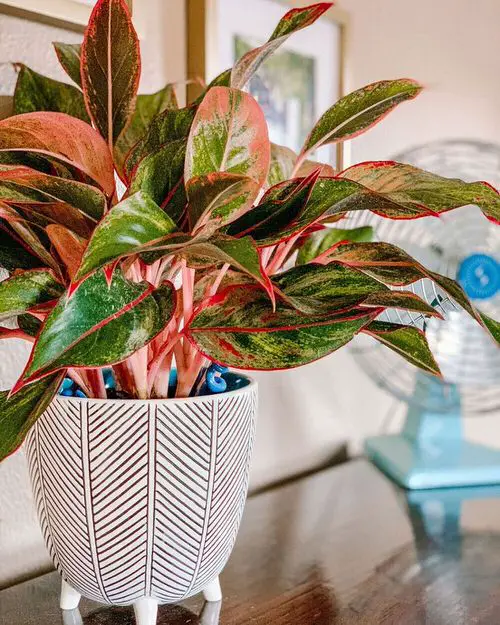Aglaonema or Chinese Evergreen Care Indoors is not difficult if you know its requirements. Learn how to grow it in this article.
The Chinese evergreen is a gorgeous houseplant native to subtropical Asia. It adapts to almost any indoor environment and its slow-growing nature makes it ideal for use as a houseplant. If you too are interested in growing it indoors, then here are some great Chinese Evergreen Care Indoors tips that’ll come in handy!
Check out our article on the best types of Aglaonema here
Choosing a Container
Depending on the size of the plant, the pot size may vary from 4 to 10 inches. If you have brought the plant from a nursery, repotting it in one size bigger pot is going to be a good start. Keeping it in a small pot will ensure that the soil is not constantly wet and this will help in preventing root rot. And yes, drainage hole is a must!
Propagation
You can divide the plant easily as it naturally propagates itself by growing suckers beneath the surface of the soil. Gently remove your plant from the pot, dust the soil and snip the suckers away and plant them into another pot and you’re done!
Requirements for Growing Chinese Evergreen

Location
As it is a popular low light plant, it can grow in indirect light, depending more on the plant variety. Green varieties of aglaonema can tolerate low-light growing conditions, but the variegated ones need to be in a spot that receives bright, indirect sunlight to maintain their spectacular leaf markings. Exposure to the morning sun is beneficial for the indoor Chinese evergreen plant.
Rotate the plant a quarter-turn every week, so it will receive equal light exposure and maintains good foliage.
Note: Avoid keeping the plant in direct sunlight all day long.
Temperature
Avoid exposing the plant to the temperature below 50 F (10 C) as this will cause dark patches on the leaves and may also damage the plant severely. Look for curling leaves or brown edges, as these are the signs of cold-temperature exposure. The plant does well between 60-80 F (15-27 C).
Soil
The soil must hold slight moisture but also needs to be well-draining at the same time. Peat based potting mix with perlite is going to work wonders for the plant. You can also go for the orchid mix or a regular potting mix for houseplants. Remember, whatever medium you choose, it needs to drain off excess water quickly.
Water
It is somewhat tolerant of low watering conditions but that doesn’t mean you should let it go without water for long. Don’t water the plant often and wait till the top layer of the soil goes a bit dry. Avoid wetting the foliage.
Humidity
Being a tropical native, Chinese evergreen thrives in a humid and warm environment. The plant can be placed on a tray filled with pebbles and water to help increase the humidity if it’s being grown in a dry environment. Just make sure that the level of water is not above the pebbles.
A Tip: Grouping indoor plants closely together will also increase the humidity in the surrounding air. This is a good trick to use if you will be away from home for a few days.
Chinese Evergreen Care
Fertilizer
The good news is, the plant is not demanding when it comes to feeding. However, to boost the growth and provide additional support, you can fertilize using a balanced liquid fertilizer, diluted to 1/4 of its strength, every 2 months. Alternatively, you can also use fish or seaweed emulsion.
Re-Potting
Aglaonema needs to be re-potted into one size bigger container, or it should be 2 inches more in diameter than the previous one, with new potting soil every 2-3 years. This plant grows best when it’s slightly root-bound, so seeing a few roots in the bottom drainage holes is acceptable.
Pests and Diseases
Chinese evergreen is susceptible to aphids, mealy bugs, red spider mites, and scale insects. Get rid of them manually or by using insecticidal soap.
In diseases, Aglaonema is susceptible to myrothecium and anthracnose leaf spots. This can cause discoloration of the foliage and holes in the leaves. Light misting of liquid copper fungicide should take care of this.
Pet Safety

According to the American Society for the Prevention of Cruelty to Animals, Chinese evergreen is mildly toxic to cats and dogs, due to the insoluble calcium oxalates. Ingesting it can cause temporary symptoms like swelling of the tongue, drooling, vomiting, and loss of appetite.



